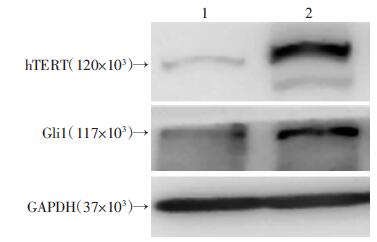人端粒酶逆转录酶(human telomerase reverse enzyme,hTERT)是端粒酶的一个亚单位,作为端粒酶的限速成分在端粒酶的活化中发挥主要作用。hTERT的表达可以代表端粒酶的活化[1, 2]。既往研究表明,端粒酶的活化以及hTERT表达参与了肿瘤侵袭转移过程[3, 4, 5, 6]。经典的Hedgehog信号通路主要由配体Hedgehog、跨膜蛋白受体patched (Ptch)和smoothened (Smo),以及转录因子Gli家族构成,其中Gli家族是Hedgehog信号通路中的核心成员[7]。Gli的激活将导致其下游一系列分子的转录,
包括上皮间叶转化(epithelial-mesenchymal transition,EMT)相关因子,如SIP1,ZFHX1B,ZEB2等[8, 9, 10]。研究表明,胃癌组织中hTERT与Gli1的表达呈显著正相关[10],提示hTERT与Gli1之前可能存在调控与被调控的关系。
本研究拟观察hTERT对Gli1表达调控的影响,并进一步探讨hTERT促进胃癌细胞侵袭转移的分子机制,为基于hTERT的胃癌治疗提供理论依据。
1 材料与方法 1.1 材料 1.1.1 试剂及仪器DMEM培养基(美国Hyclone公司),胎牛血清(美国Gibco公司);Lipofectamine 2000(美国Invitrogen公司);一抗兔Gli1抗体(美国ORIGENE公司,编号TA803969);双荧光素酶报告基因检测系统(美国Promega公司);人胃腺癌细胞株SGC-7901由本实验室保存。
2000(美国Invitrogen公司);一抗兔Gli1抗体(美国ORIGENE公司,编号TA803969);双荧光素酶报告基因检测系统(美国Promega公司);人胃腺癌细胞株SGC-7901由本实验室保存。
人胃腺癌细胞SGC-7901用含10%胎牛血清的DMEM/H培养基培养,条件为37 ℃,5% CO2。
1.2.2 RNA提取以106细胞/1 mL TRizol Reagent的比例加入TRizol Reagent,按照操作说明提取细胞RNA,溶于40 μL DEPC 水。
1.2.3 qRT-PCR检测按照Premix ExTaq试剂盒说明加入逆转录反应试剂,逆转录反应条件:37 ℃,15 min;85 ℃,5 s。合成的cDNA作为模板进行qPCR扩增,根据Premix ExTaqTM试剂盒说明加入Premix、ROX Dye Ⅱ、Primer R、Primer F、cDNA及H2O。qPCR 条件:95 ℃,2 min;40次循环于95 ℃,15 s;60 ℃,30 s,采集荧光。25 μL反应体系,GAPDH作为内参。引物序列为:Gli1-Primer F (5′-GCGTGAGCCTGAATCTGTGTAT-3′)、Gli1-Primer R (5′-TGGATGTGCTCGCTGTTGATG-3′);GAPDH-Primer F (5′-GGTGGTCTCCTCTGACTTCAACA-3′)、GAPDH-Primer R (5′- TCTCTTCCTCTTGTGCTCTTGCT-3′)。
1.2.4 Western blot检测采用RIPA法提取SGC-7901细胞总蛋白、BCA法测定蛋白浓度 (根据说明书)。取20 μg蛋白经10% SDS-PAGE 胶分离后,湿转(条件:恒流200 A,90 min)至PVDF膜上,5%脱脂奶粉封闭1 h,分别用抗Gli1的一抗(1 ∶500稀释),抗hTERT的一抗(1 ∶1 000稀释),抗GAPDH的一抗(1 ∶5 000稀释)孵育过夜,再与辣根过氧化物酶标记的山羊抗小鼠IgG孵育1 h,与辣根过氧化物酶标记山羊抗小鼠 IgG 孵育 1 h,用TBST液洗膜后曝光显色。
1.2.5 荧光素酶活性检测将SGC-7901细胞接种于96孔板,24 h后细胞贴壁汇合率达50%时共转染荧光素酶质粒Gli1-Promoter Luciferase reporter及对照质粒pRL-TK、hTERT过表达质粒pIRES2-hTERT及对照质粒pIRES2-NC。转染24 h以后,采用双荧光素酶报告基因检测系统处理细胞,用GloMax20/20 Luminometer检测荧光强度。
1.2.6 转染将SGC-7901细胞接种于6孔板,24 h 后细胞贴壁汇合率达50%进行转染,转染试剂采用Lipofectamine 2000,转染步骤按试剂说明书推荐步骤进行。si-NC的终浓度为100 nmol/L ,si-Gli1的终浓度为100 nmol/L;pIRES2-NC 的终浓度度为60 nmol/L; pIRES2-hTERT的终浓度为80 nmol/L。
2000,转染步骤按试剂说明书推荐步骤进行。si-NC的终浓度为100 nmol/L ,si-Gli1的终浓度为100 nmol/L;pIRES2-NC 的终浓度度为60 nmol/L; pIRES2-hTERT的终浓度为80 nmol/L。
委托重庆吉玛基因公司构建Gli1干扰质粒si-Gli1; 本实验室已成功构建hTERT过表达质粒(pIRES2-hTERT)及对照质粒(pIRES2-NC)[11]。经http://genome.ucsc.edu/ 获得人Gli1 的启动子序列,委托上海生工公司将Gli1的启动子序列克隆至pGL3-basic位点,构建重组萤火虫荧光素酶报告质粒pGL3-basic-Gli1,经双酶切电泳及测序鉴定质粒构建成功。
1.3 统计学方法胃癌细胞的侵袭、迁移计数以及Gli1启动子荧光素酶活性的检测均采用配对t检验,采用SPSS 19.0软件进行统计分析。
2 结果 2.1 过表达hTERT上调Gli1的表达分别转染piRES2-NC及piRES2-hTERT于SGC-7901细胞48 h之后,采用qRT-PCR和Western blot检测hTERT的蛋白水平以及Gli1 mRNA、蛋白的表达水平。过表达hTERT可明显增加Gli1 mRNA的表达,pIRES2-NC为(1.11±0.10),pIRES2-hTERT为(4.60±0.81) (P=0.003 8)和蛋白的表达(图 1)。
 |
| 1:pIRES2-NC空载质粒转染;2:pIRES2-hTERT过表达质粒转染 图 1 过表达hTERT对SGC-7901胃癌细胞Gli1 mRNA和蛋白表达的影响 |
图 1结果表明hTERT可以增加Gli1 mRNA的表达,提示hTERT可能在转录水平调控Gli 1的表达。我们进一步采用双荧光素酶实验,检测hTERT对 Gli1启动子的影响。我们构建了含Gli1启动子的荧光素酶报告载体,将hTERT过表达载体或对照载体,与Gli1启动子荧光素酶载体分别共转染SGC-7901细胞,48 h后检测荧光素酶报告基因的活性,pIRES2-NC为(0.096±0.033),pIRES2-hTERT为(0.188±0.026),hTERT可明显增强Gli1启动子的活性(P=0.003 874),提示hTERT可通过促进Gli1的转录进而增强其表达。
2.3 si-Gli1干扰Gli1的表达采用Gli1的干扰RNA si-Gli1干扰Gli1的表达,如图 2所示,SGC-7901胃癌细胞中si-Gli1显著降低了Gli1的表达。
 |
| 1:si-Gli1;2:si-NC 图 2 Western blot检测Si-Gli1干扰Gli1的表达 |
在hTERT过表达的SGC-7901胃癌细胞中同时转染si-Gli1质粒,采用划痕实验观察干扰Gli1对胃癌细胞迁移能力的影响。如图 3所示,与si-NC组相比,si-Gli1组的胃癌细胞的迁移能力明显减弱,提示干扰Gli1可显著抑制hTERT对胃癌细胞的迁移,hTERT有可能通过促进Gli1的表达并进而促进胃癌细胞的迁移。
 |
| A:hTERT+si-NC 0 h;B: hTERT+si-Gli1 0 h;C:hTERT+si-NC 48 h;D: hTERT+si-Gli1 48 h 图 3 干扰Gli1的表达可显著抑制hTERT促胃癌细胞的迁移 |
采用Transwell实验验证抑制Gli1的表达后,过表达hTERT的SGC-7901细胞侵袭能力的变化。结果显示,共转染pIRES2-hTERT、si-Gli1 24 h之后,相对于si-NC组,si-Gli1组中从膜上侧迁移至膜下侧的SGC-7901细胞数量明显减少,表明干扰Gli1的表达显著降低了SGC-7901细胞的迁移能力(图 4)。证明hTERT可通过Gli1进而促进胃癌细胞侵袭。
 |
| A: hTERT+si-NC,共转染pIRES2-hTERT、si-NC于SGC-7901细胞;B: hTERT+si-Gli1,共转染pIRES2-hTERT、si- Gli1于SGC-7901细胞 图 4 Transwell检测干扰Gli1的表达抑制hTERT对胃癌细胞侵袭能力的影响(结晶紫 ×40) |
在胃癌细胞株SGC-7901中过表达hTERT之后,Gli1的mRNA及蛋白表达水平显著上调,且Gli1启动子荧光素酶报告基因活性显著增加,而干扰Gli1的表达抑制了胃癌细胞的侵袭和迁移。提示hTERT能够调控Gli1的表达。
hTERT在胃癌转移的淋巴结组织中显著升高,与胃癌淋巴结转移情况,TNM分期,浆膜层浸润等临床病理特征密切相关[12, 13]。hTERT导致胃癌细胞发生上皮-间质EMT改变,其在胃癌组织中的表达水平与Snail1、Vimentin等呈正相关[14];干扰hTERT的表达能够抑制胃癌细胞的EMT样改变和侵袭转移。有意思的是,hTERT能够以非依赖于端粒酶活性和不改变端粒长度的条件下,促进血管内皮生长因子表达(VEGF)和肿瘤的进程[15]。hTERT同样与肿瘤的侵袭转移密切相关。因此,阐明hTERT导致胃癌侵袭转移的具体分子机制,有益于通过靶向hTERT的表达从而抑制肿瘤细胞侵袭转移。hTERT 本质上是一种酶,文献[16]报道hTERT 能够与NF-κB 的p65 亚基结合并促进p65 的入核,进而影响大部分NF-κB 的下游基因的表达;此外,研究亦表明hTERT能够通过与β-catenin蛋白-蛋白相互作用后促进Wnt通路下游靶基因的表达[17]。也就是说hTERT可以作为co-activator,通过影响某些转录因子的表达最终影响靶基因的表达。据此,有理由推测hTERT引起的Gli1表达变化可能原因是,hTERT作用于某些转录因子,通过与转录因子结合后,共同作用于Gli1的启动子区域,影响其功能或者其表达水平。
Gli1是Hedgehog信号通路中的主要成员之一,其表达的高低显著影响了该信号通路的活性。有研究表明,Gli1的转录主要受一段长达1.4 kb的序列调控,该序列包含 5侧翼序列、一个非编码外显子以及425 bp 处的内含子。Gli1的核心启动子区位于-357~+130,富含GC序列和CpG岛,而缺乏TATA框、CCAAT框。c-MYC和Twist能与该序列上的E-box结合,促进Gli1的转录[18]。Beauchamp等[19]报道,在Gli1启动子区域含有多个EWS-FLI1 蛋白结合序列GGAA,EWS-FLI1能与这些位点结合进而上调Gli1的转录水平。这些研究提示hTERT可能与Gli1的转录因子相互作用,共同启动Gli1基因的转录。本研究明确了Gli1在胃癌细胞侵袭转移中的作用,证实了hTERT通过转录后调控Gli1的表达。
| [1] | Yu L, Liu S, Zhang C, et al. Enrichment of human osteosarcoma stem cells based on hTERT transcriptional activity[J]. Oncotarget, 2013, 4(12): 2326-2338. |
| [2] | Deeb D, Gao X, Liu Y, et al. Inhibition of cell proliferation and induction of apoptosis by oleanane triterpenoid (CDDO-Me) in pancreatic cancer cells is associated with the suppression of hTERT gene expression and its telomerase activity[J]. Biochem Biophys Res Commun, 2012, 422(4): 561-567. |
| [3] | Hu C, Ni Z, Li B S, et al. hTERT promotes the invasion of gastric cancer cells by enhancing FOXO3a ubiquitination and subsequent ITGB1 upregulation[J]. Gut, 2015, pii: gutjnl-2015-309322. |
| [4] | Zhao T, Hu F, Qiao B, et al. Telomerase reverse transcriptase potentially promotes the progression of oral squamous cell carcinoma through induction of epithelial-mesenchymal transition[J]. Int J Oncol, 2015, 46(5): 2205-2215. |
| [5] | Chen R, Zhu J, Dong Y, et al. Suppressor of Ty homolog-5, a novel tumor-specific human telomerase reverse transcriptase promoter-binding protein and activator in colon cancer cells[J]. Oncotarget, 2015, 6(32): 32841-32855. |
| [6] | Lu M H, Deng J Q, Cao Y L, et al. Prognostic role of telomerase activity in gastric adenocarcinoma: A meta-analysis[J]. Exp Ther Med, 2012, 3(4): 728-734. |
| [7] | Briscoe J, Therond P P. The mechanisms of Hedgehog signalling and its roles in development and disease[J]. Nat Rev Mol Cell Biol, 2013, 14(7): 416-429. |
| [8] | Chen X, Lingala S, Khoobyari S, et al. Epithelial mesenchymal transition and hedgehog signaling activation are associated with chemoresistance and invasion of hepatoma subpopulations[J]. J Hepatol, 2011, 55(4): 838-845. |
| [9] | Yoo Y A, Kang M H, Lee H J, et al. Sonic hedgehog pathway promotes metastasis and lymphangiogenesis via activation of Akt, EMT, and MMP-9 pathway in gastric cancer[J]. Cancer Res, 2011, 71(22): 7061-7070. |
| [10] | 魏青林, 张丹, 杨仕明. 端粒酶逆转录酶和Gli1、Gli2在胃癌中的表达及意义[J].第三军医大学学报, 2015, 37(9): 902-906. |
| [11] | Yu S T, Chen L, Wang H J, et al. hTERT promotes the invasion of telomerase-negative tumor cells in vitro[J]. Int J Oncol, 2009, 35(2): 329-336. |
| [12] | Tahara E. Molecular aspects of invasion and metastasis of stomach cancer[J].Verh Dtsch Ges Pathol, 2000, 84: 43-49. |
| [13] | 张帆,郝迎学,唐波,等.不同浆膜受侵犯面积胃癌患者行腹腔镜胃癌根治术对腹腔微转移的影响[J].中华消化外科杂志, 2015, 14(5): 400-404. |
| [14] | Liu Z, Li Q, Li K, et al. Telomerase reverse transcriptase promotes epithelial-mesenchymal transition and stem cell-like traits in cancer cells[J]. Oncogene, 2013, 32(36): 4203-4213. |
| [15] | Zhou L, Zheng D, Wang M, et al. Telomerase reverse transcriptase activates the expression of vascular endothelial growth factor independent of telomerase activity[J]. Biochem Biophys Res Commun, 2009, 386(4): 739-743. |
| [16] | Ding D, Xi P, Zhou J, et al. Human telomerase reverse transcriptase regulates MMP expression independently of telomerase activity via NF-kappaB-dependent transcription[J]. FASEB J, 2013, 27(11): 4375-4383. |
| [17] | Listerman I, Gazzaniga F S, Blackburn E H. An investigation of the effects of the core protein telomerase reverse transcriptase on Wnt signaling in breast cancer cells[J]. Mol Cell Biol, 2014, 34(2): 280-289. |
| [18] | Yoon J W, Gallant M, Lamm M L, et al. Noncanonical regulation of the Hedgehog mediator GLI1 by c-MYC in Burkitt lymphoma[J]. Mol Cancer Res, 2013, 11(6): 604-615. |
| [19] | Beauchamp E, Bulut G, Abaan O, et al. GLI1 is a direct transcriptional target of EWS-FLI1 oncoprotein[J]. J Biol Chem, 2009, 284(14): 9074-9082. |



